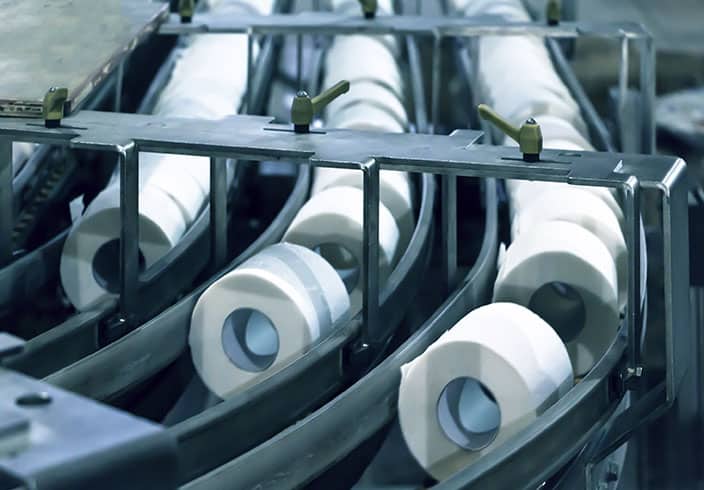Packaging, newspapers, books or sanitary paper – the paper industry has a high value and an important function. With a share of over 25 per cent, Germany’s paper industry, for example, is the largest in Europe and ranks fourth globally – after China, the USA and Japan (source: bmwk).
According to the Confederation of European Paper Industries (Cepi), the European paper industry produces about 84.8 million tonnes of paper, board and cardboard annually. About 647,000 employees generate a turnover of 180 billion euros (source: European Comission). In the past two years in particular, the pulp and paper industry has been in the headlines due to supply bottlenecks, increased demand and shortages in the supply chain.
In terms of energy demand, the paper industry is one of the most energy-intensive industries. This is because a lot of electricity is required to operate the production facilities – especially to remove the water necessary for paper production from the paper web again. According to current statistics from Statista Research, the paper industry consumed a total of around 1,361 petajoules of energy in 2021 (source: eurostat).
Like all energy-intensive industries, the paper industry is continuously looking for ways to make CO2-neutral production possible in the long term. These include an increased focus on recovered paper utilisation and recycling cycles as well as the possibility of using modern technologies such as thermal energy storage solutions in production.
Energy consumption in paper production
According to the industry association “Cepi“, more than 60 per cent of the energy required for paper production already comes from renewable energy sources such as sun and wind. Many production sites operate their own combined heat and power (CHP) plants. But to ensure affordable, continuous security of supply, fossil fuels and especially natural gas are (still) used.
Paper production and environmental impact: Life cycle assessment and CO2 emissions of paper
In terms of environmental impact, the production of paper varies greatly depending on the type and recyclability of the fibres. According to figures from the European Commission, the waste paper return rate was around 70 per cent (source: European Commission). The printing professional ezeep has calculated that the production of one kilogram of paper produces on average about one kilogram of CO2 – for virgin fibre it is 1.2 kilograms, for recycled paper 0.7 kilograms. (Source: ezeep).
Supply bottlenecks in the paper industry: dependence on fossil energy
Although the paper industry strives to cover a large part of its energy needs with its own plants and regenerative energy sources, fossil energy sources are still used, especially for cost reasons. For many production processes, gas can hardly be substituted in paper manufacturing. Gas, especially natural gas, is used, among other things, to generate steam, which is needed for recycling waste paper and for drying paper.
Against this background, of course, the highly tense geopolitical situation is also causing problems for the paper industry. For example, the German industry association “Die Papierindustrie” warned shortly after the start of the war in Ukraine in 2022 that in the event of a gas supply failure or a reduction in the amount of gas available, German paper manufacturers would be able to obtain a maximum of ten 15 per cent of the energy they need from other sources. Accordingly, the industry is continuously looking for solutions to replace fossil natural gas. With the potential for process electrification on the horizon, thermal energy storage systems are gaining significant interest.
High paper demand for sustainable packaging
Paper packaging is increasingly being used as a sustainable alternative to plastic in all branches of industry. Although this is positive in principle from a sustainability point of view, the high energy consumption of the paper industry is a challenge that seeks answers.
Experts are convinced: even though the paper industry is energy-intensive, sustainable measures such as active recycling and thermal energy storage solutions can make a big difference in paper mills. If recycled fibres are used for paper production, for example, the CO2 balance is significantly lower. On the other hand, less energy is needed for the process as a whole. According to the German Federal Environment Agency, the production of recycled paper saves an average of 78 per cent water, 68 per cent energy and 15 per cent CO2 emissions compared to paper made from so-called primary pulp – usually wood. (Source: Umweltbundesamt).
How the paper industry can reduce its energy consumption and environmental impact
Experts also see great potential in the increasing electrification of the processes involved. For example, the German government writes in a recent findings paper: “Due to the large share of low to medium temperature heat in the total energy demand of the paper industry, the electrification of process steam generation is an important part of decarbonisation.” (Source: bmwk)
Paper industry of the future: Profitable, sustainable production with thermal energy storage
Thermal energy storage systems can help the paper industry save costs and emissions in the long term due to their high flexibility, durability and efficiency. As flexible storage solutions, they can make a decisive contribution to advancing the electrification of paper production and recycling processes. Waste heat can also be recovered easily, as surplus energy is stored during production and made usable with a time delay. An important advantage: the thermal storage units can be charged with green electricity when this is available in large quantities and is therefore particularly cheap. The energy is then stored inside the thermal energy storage units in the form of heat. Process heat and industrial steam can then be provided whenever they are needed.
What are the advantages of the ThermalBattery™ from ENERGYNEST?
With its ThermalBattery™, ENERGYNEST offers state-of-the-art thermal energy storage solutions that can increase energy efficiency in pulp and paper manufacturing and are precisely tailored to the individual needs of different production sites. As part of a decarbonisation strategy, the ThermalBattery™ can help industrial operations electrify their heat by storing renewably generated energy at opportune times – and making it available to industrial processes on a time-delayed basis. “Using thermal storage, companies can reduce their energy costs and decarbonise their energy consumption at the same time,” says ENERGYNEST Managing Director Christian Thiel.
The batteries themselves have a long service life and, depending on the delivery model, can also be purchased fully financed with no acquisition costs.
For energy-intensive industries such as the pulp and paper industry, this technology has great potential and can contribute quite decisively to the long-term decarbonisation of the sector.
Are you interested in ENERGYNEST, or have any questions regarding our thermal energy storage solutions or our applications for your specific industry?
Don’t hesitate to drop us a line.



